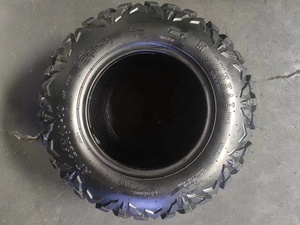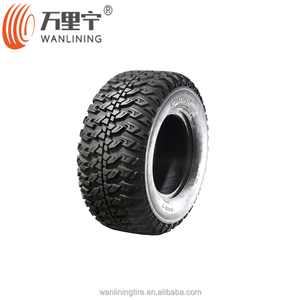(4758 products available)



























































































































































































All-Terrain Tires
All-terrain tires, or \"mud and sand tires\" as they are sometimes referred to, are the workhorses of the tire industry. They can traverse any terrain, from rocky paths to muddy grounds and sandy beaches, making them ideal for those who don't want to swap tires for different conditions. The tread pattern on these 10 ATV tires is balanced, with enough grip for off-road adventures and a smooth ride for on-road travel. However, while they perform adequately in all areas, they may not be the best choice for more specialized tasks. For instance, in deep mud, the tread may not clear as efficiently as a dedicated mud tire, or on sand dunes, the flotation may be less than optimal compared to a sand-specific tire.
Mud Tires
Mud tires are specifically designed for muddy terrains and come equipped with deep, aggressive treads that excel in gripping loose soil and debris. These treads also feature wide channels that swiftly eject any accumulated mud and debris from the tire, ensuring optimal traction. Although mud tires are exceptional in muddy conditions, their performance may be compromised when used on hard-packed trails or paved roads due to the softer rubber compounds.
Sand Tires
Sand tires are perfect for desert landscapes and sandy beaches. They have paddles or floatation-designed lugs that allow the ATV to glide over sand dunes without sinking. These features ensure that the ATV can navigate sandy terrains without difficulty, maintaining momentum and preventing the vehicle from getting stuck. However, their specific design can limit performance on other types of terrain, and the rubber compounds used are softer, leading to quicker wear on paved surfaces.
Trail Tires
Trail tires are designed for rocky and wooded trails. They often have a moderate tread depth and a versatile tread pattern that strikes a balance between traction and durability. This makes them suitable for various terrains, from rocky paths to forested areas. The rubber is often more durable than that used in mud or sand tires, making them last longer on hard-packed trails. While trail tires work well in off-road settings, they may not perform optimally in extreme environments, such as deep mud or loose sand.
Snow and Ice Tires
Snow and ice tires are made for winter riding. They have a unique rubber formula that stays flexible in cold weather, along with deep treads and studs or a siping pattern that offers excellent grip on icy roads. The siping pattern increases traction on slippery surfaces by creating smaller slits in the tire tread, enhancing grip by increasing the number of edges that come into contact with the ground. Nonetheless, their specific winter tread may lead to reduced performance on warm-weather trails.
When it comes to 10-inch ATV tires, stock specifications are often not enough for specific off-road needs. Here are some general conditions and requirements:
Tire Size
Dimensions are expressed in three parts. The first number is the tire's width in millimeters. The following number is the aspect ratio, which indicates the percentage of tire height to width. The last number is the rim diameter in inches. For example, a 10x6 tire has a width of 10.2 mm, an aspect ratio of 80%, and a 6-inch diameter.
Tread Pattern
Off-road tires have distinctive deep, aggressive treads that provide grip on loose ground. The tread depth and design should be enough for the specific terrain type (mud, sand, rocks, etc.).
Load Rating
Each tire has a load capacity that must be considered when selecting and configuring the ATV. The total load on all tires should not exceed the specified value.
Speed Rating
ATV tires have a lower speed rating than regular vehicle tires. For this reason, they are designed for high levels of safety and stability on off-road terrain at lower speeds.
10 ATV tires require special care to ensure durability and reliability. Here are some general maintenance tips:
Tire Pressure
Before and after each ride, check the pressure and adjust it according to the manufacturer's specifications. Proper pressure ensures even wear and reliable grip.
Tread Depth
Monitor tread depth and replace tires when worn out. Worn tires reduce traction and can lead to unsafe conditions.
Visual Inspection
Look for damage, foreign objects, or irregularities in the tread. Remove stones, sticks, or other debris to avoid punctures or imbalances.
Rotation
Regularly change tire positions to ensure even wear. Front tires wear differently than rear tires, so changing their positions will increase their service life.
Cleaning
Clean tires after riding in muddy or sandy areas. Accumulated dirt can lead to uneven wear and deterioration of the rubber.
Storage
If changing the tires for the season, store them in a dry, dark place away from direct sunlight and aggressive chemicals. Proper storage preserves rubber properties.
Following these guidelines will ensure that 10-inch ATV tires serve reliably and durably in all-terrain conditions.
Here's a buying guide for choosing the right size and type of ATV tires:
Understanding ATV tire size:
ATV tire size is important for safety and performance. It affects ground clearance, handling, and speed. The size is found on the sidewall and has three numbers separated by dashes. The first number is the width in inches. The second number is the height-to-width ratio in percent. The third number is the diameter of the wheel in inches. A larger tire gives more ground clearance and traction but makes the ATV slower. A smaller tire does the opposite.
Choosing the right size:
Buyers should choose tires that match the wheel size and riding style. For example, 10-inch ATV tires are good for trails and light mud. They improve acceleration and handling. 26-inch tires are better for deep mud and rough terrain. They provide more ground clearance and tire width.
Understanding tire construction:
The two-ply tires are light and cheap but not very strong. They are best for paved roads or smooth trails. Three-ply tires are a good balance between strength and weight. They suit most riding conditions. Four- or six-ply tires are very tough. They can carry heavy loads and are good for aggressive off-road riding.
Choosing the right tire construction:
Ten ATV tires with three or four plies are suitable for regular use. Riders should check the ply rating and other details on the tire's sidewall. This helps to know the tire's ability and features.
Choosing the right type of 10 ATV tires:
Business owners should select tires that match the terrain and riding style. For example, mud tires have deep treads for good grip in mud. Sand tires are better for sandy areas. Trail tires are great for mixed terrains like trails, roads, and light off-road.
Tread design and pattern:
Tread design affects traction and tire wear. Aggressive treads give more grip but wear out fast. Less aggressive treads last longer but have a lower grip. Buyers should think about the trade-off between traction and tire life.
Load capacity and ply rating:
The load capacity tells how much weight the tire can support. The ply rating is a measure of tire strength. Buyers should check the ATV's owner's manual for load and tire information. This ensures they select tires that are safe and fit well.
Riding style:
Buyers should consider their riding style when buying tires. Trail tires are good for all trails, roads, and off-road. Mud tires work well in mud but not on roads. Sand tires are best for sandy places.
Replacing 10-inch ATV tires is a straightforward process that can be done with basic tools. Here's a step-by-step guide on how to replace them:
Repeat these steps for the remaining wheels if replacing more than one. Once all tires are replaced, perform a final inspection to ensure proper installation and check the tire pressure using a tire pressure gauge.
With the new 10-inch ATV tires installed, the vehicle is ready for safe and optimal off-road performance.
Q1: How long do 10-inch ATV tires last?
A1: There is no specific timeline for tire replacement since the durability of 10 ATV tires depends on various factors. However, the general rule is to replace them after 1, 2, or 3 worn-out stages. The timeframe can be affected by riding style, terrain, and tire construction.
Q2: Can any tire fit on an ATV?
A2: No, ATVs are designed with specific tire sizes. For instance, the vehicle's 10-inch rim can accommodate tires with a 10-inch bead. Ensure the new tires match the current size for optimal performance.
Q3: Are 10-inch ATV tires suitable for mudding?
A3: Yes, the 10-inch tires can be used for mudding. However, buyers should check the specific tire model's tread pattern and its suitability for muddy terrains. Consider a different size if the 10-inch tires are unsuitable for mudding.